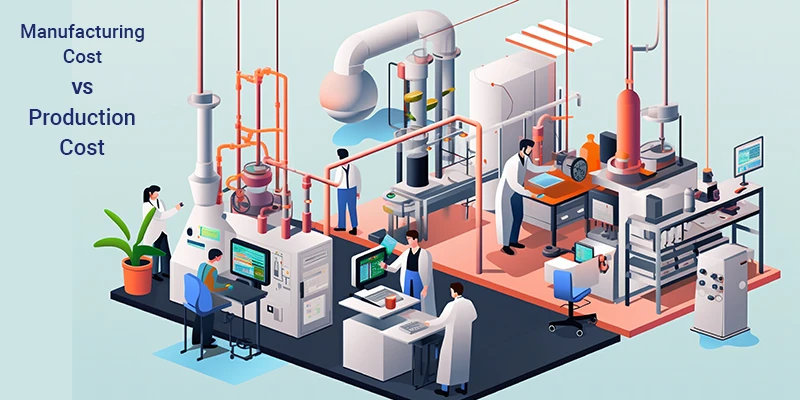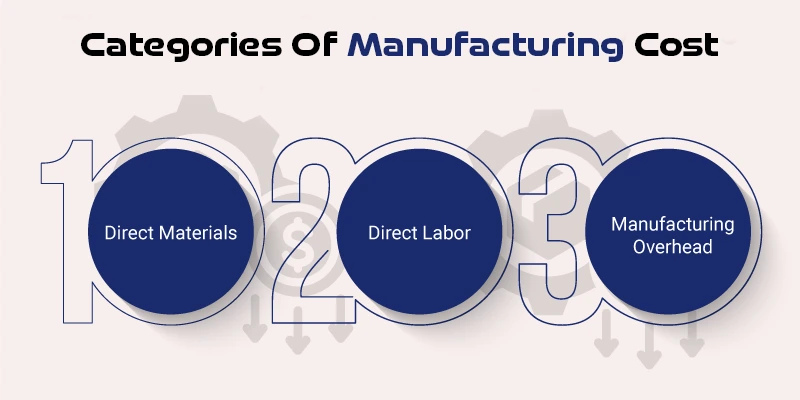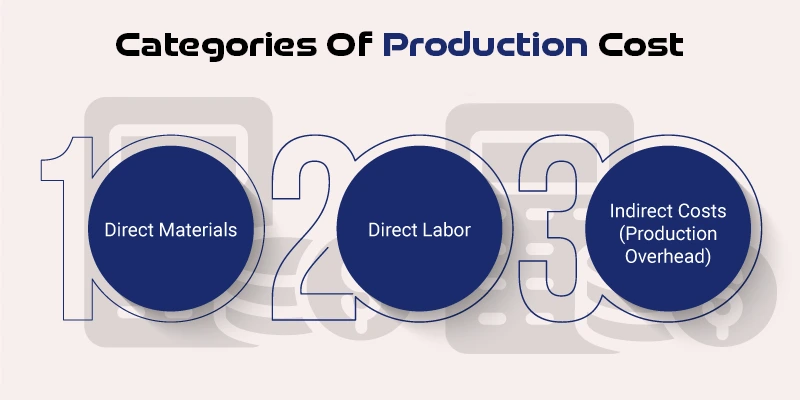
To run a successful business, two critical terms that often come up in discussions about expenses are manufacturing cost and production cost. They may seem similar, but represent different aspects of the production process and can impact your financial decisions in distinct ways.
In this blog, we’ll explore the differences between manufacturing cost and production cost, shedding light on how each plays a role in shaping your business’s bottom line. Let's dive in and understand the true cost of production.
What is Manufacturing Cost?
Manufacturing cost refers to all expenses directly associated with producing a product. It is specifically concerned with the costs incurred in the transformation of raw materials into finished goods. These costs can be divided into three main categories:

1. Direct Materials
Direct materials are the raw materials that are used directly in the creation of a product. These materials become an integral part of the finished product.
For example, in car manufacturing, steel, rubber, and glass are direct materials. In food manufacturing, ingredients like flour, sugar, and oil are considered direct materials. The cost of these materials is an essential part of the manufacturing cost calculation.
2. Direct Labor
Direct labor refers to the wages and salaries of workers who are directly involved in the production process. These workers are physically engaged in the creation of the product. For instance, assembly line workers, machine operators, or those responsible for packaging the products fall under this category. The direct labor cost is a crucial component, as it directly impacts the overall cost of manufacturing.
3. Manufacturing Overhead
Manufacturing overhead includes all the indirect costs associated with the production process. These are costs that cannot be traced directly to a specific product but are still essential for manufacturing operations. Manufacturing overhead typically includes:
- Factory Rent: The cost of leasing or owning the factory building where production takes place.
- Utilities: Electricity, water, and gas bills for the factory.
- Depreciation: The wear and tear of machinery and equipment over time.
- Maintenance: Regular repairs and upkeep of machines and tools.
- Factory Supervisors' Salaries: Wages paid to supervisors who manage the production process.
Together, these components form the total manufacturing cost, which is crucial for understanding the direct expenses related to producing a product.
What is Production Cost?
Production cost is a broader term that refers to the total cost of creating goods or services. It includes not only manufacturing costs but also other expenses tied to the overall production process.
Production cost consists of the following:

1. Direct Materials
Just like in manufacturing cost, direct materials in production costs represent the raw materials used to produce goods. However, production costs may also include materials that go into packaging or shipping the product.
For example, if a company produces toys, the cost of packaging the toys, labeling them, and preparing them for shipment is included in production cost.
2. Direct Labor
In production cost, direct labor covers not only the manufacturing workers but also other labor expenses that go beyond the factory floor. This includes the wages of workers in departments like research and development, design, planning, and quality control, which are vital for the production process but aren’t directly tied to the physical act of making the product.
3. Indirect Costs (Production Overhead)
Production overhead includes both manufacturing overhead and additional indirect costs that are necessary for bringing a product to market. These might involve:
- Logistics and Shipping: The costs associated with transporting the raw materials to the factory or delivering the finished goods to retailers or consumers.
- Inventory Storage: Expenses tied to warehousing and storing materials or finished products.
- Quality Control: Ensuring the product meets standards, which involves inspecting, testing, and adjusting production.
- Research & Development (R&D): The costs of designing and improving products, including salaries for R&D staff.
- Marketing and Distribution Costs: Though not always included in production costs, these expenses may be considered in broader production cost analysis if the business sees them as part of the total production cycle.
The production cost provides a comprehensive view of all costs required to bring a product from the concept phase to the consumer, beyond just the actual manufacturing.
Read More: Factors To Consider When Procuring Goods Or Services Globally
Empower Your Business with Data-Driven Supply Chain Management from SIXM
Understanding the difference between manufacturing cost and production cost is essential for optimizing your operations and improving profitability. By effectively managing both, businesses can reduce inefficiencies and enhance their bottom line.
At SIXM, we specialize in providing comprehensive supplier management services that help businesses streamline their production processes. Our data-driven solutions ensure that you stay ahead of the curve, balancing cost efficiency with quality. Let us help you optimize your supply chain and drive sustainable growth.
Frequently Asked Questions
Yes, both production and manufacturing costs play a significant role in determining the pricing of a product. A company must ensure that the price it charges covers both direct and indirect costs. At the same time, it must remain competitive in the market. If manufacturing and production costs are too high, the company may need to raise prices. However, this could negatively impact demand. Alternatively, the company might need to find ways to cut costs in order to maintain a competitive price point.
Technology can significantly reduce both production and manufacturing costs by improving efficiency, accuracy, and speed. Automated production lines, AI-driven supply chain management, and advanced data analytics can help businesses identify inefficiencies, reduce waste, and optimize labor. Investing in technology can also lead to more consistent product quality, minimizing defects and reducing the costs associated with returns or rework.
Yes, production costs can be lowered without compromising quality through strategies such as improving supply chain management, reducing waste, and optimizing logistics. By carefully managing procurement, production processes, and distribution channels, businesses can find areas for cost reductions while still maintaining product standards. Continuous improvement and cost-saving initiatives are key to maintaining quality and enhancing operational efficiency.
Accurate costing methods are essential for effectively planning and budgeting business operations. They help businesses understand the total investment required to start and maintain a business. By using precise costing techniques, businesses can allocate resources wisely, avoid financial difficulties, and identify potential funding gaps. Accurate costing also supports better financial decision-making, helping businesses optimize their operations and secure necessary capital for growth.
No, production costs and total costs are different. Production costs only cover the expenses associated with manufacturing goods, including materials, labor, and overhead. Total costs, on the other hand, include all business-related expenses, such as production costs, marketing expenses, administrative costs, and other operational expenditures. Production costs are a subset of total costs.
Yes, manufacturing costs can exceed production costs under certain circumstances. This can happen when the production process is straightforward and efficient, meaning most expenses are incurred during manufacturing. In such cases, manufacturing costs (including labor, equipment, and overhead) may surpass the costs incurred during other production-related phases, such as research and planning.
The costing method that charges all manufacturing costs to its products is Absorption Costing. This method includes all costs—both fixed and variable—such as direct materials, direct labor, and both fixed and variable manufacturing overheads, in the product cost.
- FIFO (First-In, First-Out): Assumes that the first items purchased are the first ones used or sold. It values inventory based on the earliest costs.
- LIFO (Last-In, First-Out): Assumes that the most recently purchased items are the first ones used or sold. This method can lead to a higher cost of goods sold (COGS) during inflationary periods.
- Average Costing: Calculates the cost of inventory based on the average cost of all units available for sale during a period. This method smoothes out price fluctuations.
It depends on the nature of the business. If a company is heavily focused on the manufacturing process and production is straightforward, reducing manufacturing costs (materials, labor, and overhead) might have the most significant impact.
However, for businesses that involve complex production processes, including research and development, logistics, and packaging, focusing on reducing production costs (which are broader and include all production-related expenses) can lead to more substantial cost savings.
Yes, industries with complex manufacturing processes—such as automotive, electronics, pharmaceuticals, and food production—greatly benefit from understanding production costs. These industries often have a wide range of indirect costs that need to be considered alongside direct manufacturing costs. Properly managing these can help them optimize their supply chains, improve product consistency, and remain competitive.
Fixed costs (such as factory rent or salaried labor) remain constant regardless of production volume, while variable costs (like raw materials and direct labor) fluctuate based on production levels.
In production cost calculations, it's essential to account for both, as fixed costs impact long-term cost structures, while variable costs are more directly tied to production output. Properly separating and tracking these costs ensures accurate pricing, budgeting, and financial forecasting.

